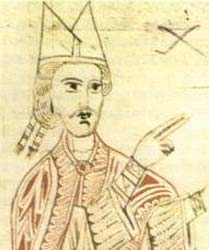Pope Gregory VII
Pope Gregory VII (Latin: [Gregorius Septimus] Error: {{Lang}}: text has italic markup (help); 1020–May 25, 1085), born Hildebrand (Italian: Ildebrando di Soana), was an Italian priest of the Roman Catholic Church and the 158th Pope from April 22, 1073 until he died in 1085.[1]
| Gregory VII | |
|---|---|
 | |
| Papacy began | April 22, 1073 |
| Papacy ended | May 25, 1085 |
| Predecessor | Pope Alexander II |
| Successor | Pope Victor III |
| Personal details | |
| Birth name | Ildebrando di Soana |
| Born | 1020 Sovana, Italy |
| Died | May 25, 1085 Salerno |
| Other Popes named Gregory | |
Early life
Hildebrand was born in Sovana in Tuscany. As a youth, he became a Benedictine monk.[2]
In Rome, Hildebrand became the chaplain of Pope Gregory VI. When Gregory VI abdicated and went into in exile in Germany, Hildebrand went with him.[2]
Cardinal
Pope Leo IX raised Hildebrand to the rank of Cardinal in 1049.[2]
Pope
Cardinal Hildebrand was elected pope on April 22, 1073; and he chose to be called Gregory.[3]
Pope Gregory was involved in Italian and European political disputes.[2]
After his death
Pope Gregory died an exile in Salerno. His last words were: "I have loved justice and hated iniquity; therefore, I [now] die in exile." ("Dilexi iustitiam et odivi iniquitatem propterea morior in exilio")..[4]
Gregory was recognized as a saint in 1728..[2]
Gallery
Pope Gregory VII Media
Related pages
References
- ↑ "List of Popes," Catholic Encyclopedia (2009); retrieved 2011-12-1.
- ↑ 2.0 2.1 2.2 2.3 2.4 "Pope St. Gregory VII," Catholic Encyclopedia; retrieved 2011-12-1.
- ↑ Society for the Diffusion of Useful Knowledge. (1838). "Gregory VII," Penny cyclopaedia, Vol. 11, pp. 444-446.
- ↑ Douglas, J. James Dixon. (1992). "Gregory VII," Who's Who in Christianity, p. 288.
Other websites
![]() Media related to Gregorius VII at Wikimedia Commons
Media related to Gregorius VII at Wikimedia Commons
 "Pope St. Gregory VII". Catholic Encyclopedia. New York: Robert Appleton Company. 1913.
"Pope St. Gregory VII". Catholic Encyclopedia. New York: Robert Appleton Company. 1913.- "Gregory VII", Encyclopædia Britannica, 1911
- Catholic Hierarchy, Popes in sequence
- Cardinals of the Holy Roman Church Archived 2011-10-30 at the Wayback Machine, Cardinal Ildebrando Archived 2011-11-29 at the Wayback Machine
| Preceded by Alexander II |
Pope 1073–1085 |
Succeeded by Victor III |


